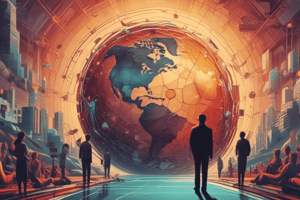Podcast
Questions and Answers
What has been a significant evolution in the role of Human Resource Management (HRM)?
What has been a significant evolution in the role of Human Resource Management (HRM)?
- From a strategic partner to a traditional personnel function
- From administrative tasks to outsourcing HR processes
- From compliance management to employee engagement
- From a traditional personnel function to a strategic partner (correct)
Which of the following is NOT a current strategic issue in HRM?
Which of the following is NOT a current strategic issue in HRM?
- Leveraging technology
- Global competition
- Mergers and acquisitions
- Employee compensation management (correct)
How does globalization affect Human Resource Management?
How does globalization affect Human Resource Management?
- It simplifies compliance with labor laws
- It limits access to international talent
- It increases competition and interconnectedness (correct)
- It reduces the need for specialized skills
What factor is critical in aligning HR practices with organizational strategies?
What factor is critical in aligning HR practices with organizational strategies?
Which aspect is essential for managing remote work in HRM?
Which aspect is essential for managing remote work in HRM?
What role does technology play in the evolution of HRM?
What role does technology play in the evolution of HRM?
Which factor has directly influenced the shift towards knowledge-based jobs?
Which factor has directly influenced the shift towards knowledge-based jobs?
What is a crucial component of the tools for implementing HRM strategy?
What is a crucial component of the tools for implementing HRM strategy?
What is a key focus of Human Capital in HRM?
What is a key focus of Human Capital in HRM?
What does International HRM (IHRM) primarily manage?
What does International HRM (IHRM) primarily manage?
Which of the following is NOT a goal of HRM?
Which of the following is NOT a goal of HRM?
What is the primary purpose of HR Information Technology?
What is the primary purpose of HR Information Technology?
Which statement best describes the role of managers in HRM?
Which statement best describes the role of managers in HRM?
Which aspect is part of the process of developing an effective workforce?
Which aspect is part of the process of developing an effective workforce?
What is the main goal of the Matching Process in HRM?
What is the main goal of the Matching Process in HRM?
Which of the following is considered a non-monetary benefit in compensation?
Which of the following is considered a non-monetary benefit in compensation?
Flashcards
Strategic HRM
Strategic HRM
HRM that aligns with organizational objectives to boost productivity and success.
Global Competition
Global Competition
The challenge of competing effectively in a global marketplace.
HR Alignment
HR Alignment
Matching HRM practices with organizational goals and strategies.
Talent Acquisition
Talent Acquisition
Signup and view all the flashcards
Technology Impact
Technology Impact
Signup and view all the flashcards
Knowledge Work
Knowledge Work
Signup and view all the flashcards
Mergers/Acquisitions
Mergers/Acquisitions
Signup and view all the flashcards
HR Tools
HR Tools
Signup and view all the flashcards
Human Resource Management (HRM)
Human Resource Management (HRM)
Signup and view all the flashcards
Human Capital
Human Capital
Signup and view all the flashcards
International HRM (IHRM)
International HRM (IHRM)
Signup and view all the flashcards
HR Planning
HR Planning
Signup and view all the flashcards
Training and Development
Training and Development
Signup and view all the flashcards
Performance Appraisal
Performance Appraisal
Signup and view all the flashcards
Compensation
Compensation
Signup and view all the flashcards
HR Information Technology (HRIT)
HR Information Technology (HRIT)
Signup and view all the flashcards
Study Notes
Human Resource Management (HRM)
- HRM has evolved from a traditional personnel function to a strategic partner for organizational goals.
- Strategic objectives align HRM with organizational objectives.
- HRM plays a crucial role in workforce management for organizational goals.
Current Strategic Issues in HRM
- Global Competition: Competing effectively in the global market is essential.
- Quality and Service: Enhancing quality, productivity, and customer service is important.
- Mergers and Acquisitions: Managing the complexities of mergers and acquisitions is a key issue.
- Technology: Integrating technology to support e-business and virtual workspaces is crucial.
- Talent Acquisition: Securing international talent is necessary to compete globally.
Factors Affecting HRM
- Globalization: Economies are interconnected.
- Technology: Rapid technological advancements impact HR practices.
- Knowledge Work: Shifting towards jobs that need specialized skills.
- Market Dynamics: The market is constantly changing.
- Societal Trends: Shifting societal norms influence the workplace.
- Government Regulations: Compliance with labor laws and regulations.
- Organizational Culture: Shared values and beliefs shape the workplace.
- Organizational Structure: Formal framework that defines roles and relationships.
- Strategy and Goals: Aligning HR practices with the organization's overall strategy.
Tools for Implementing Strategy
- Leadership: Effective leadership motivates and shapes organizational culture.
- Structural Design: A structure that supports the strategy is important for implementation.
- Information and Control Systems: Utilize systems for performance monitoring and decision-making.
- Human Resources: Recruitment, selection, development, and maintenance of an effective workforce are crucial.
The Changing Landscape of HRM
- Global HR Strategies: Strategies that address global workforce complexities are necessary.
- Human Capital: Building and developing the organization's human assets is vital.
- Information Technology: Utilize technology to streamline HR processes and enhance decision-making.
Human Capital and IHRM (International HRM)
- Human Capital: The economic value of employee knowledge, skills, and capabilities.
- IHRM: Managing global teams to handle recruitment, selection, development, and retention.
Information Technology in HRM
- HR Information Technology: Integrated computer systems provide data for HR decisions.
- e-HR: Shift from traditional methods to electronic HR systems to streamline and reduce costs.
Elements of HRM
- Managers as Resource Managers: Managers have a role in managing human resources.
- Employees as Assets: View employees as valuable resources and assets rather than costs.
- Matching Process: Achieving alignment between organizational goals and employee needs.
HRM Goals
- Attracting an Effective Workforce: Recruiting and selecting qualified candidates.
Developing/Attracting/Maintaining an Effective Workforce
- Developing: Providing training, development, and appraisal for an effective workforce.
- Attracting: Forecasting needs, matching candidates, recruiting/selecting qualified people to meet the organization's requirements.
- Maintaining: Compensation, benefits, positive labor relations, and the termination process are all important to keep employees.
Studying That Suits You
Use AI to generate personalized quizzes and flashcards to suit your learning preferences.
Description
This quiz explores the evolution of Human Resource Management (HRM) and its critical role as a strategic partner in achieving organizational goals. It covers contemporary issues such as global competition, technology integration, and talent acquisition that shape HRM today. Test your knowledge on how these factors affect HR practices and workforce management.




